
|
Sale 119
THE NEW YORK SALE
| Lot |
Photo |
Description |
Realized |
Lot 3115 |
 |
Edward III (1327-77), Gold Half-Noble of three shillings and four pence. Tower Mint London, Fourth Coinage, Transitional Treaty Period (1360-61) King standing in ship with upright sword and quartered shield, beaded circle surrounding, E DWARDxx DEIxx GxxREXxx AnG Lxx D'x hIBxZx, rev. large E at centre of ornamental cross with lis terminals, crowns over lions in angles, all within a beaded and linear tressure, fleurs in spandrels, legend +DomInEx Inx FVROREx TVOx ARGVASx mE, weight 3.89g (Schneider 65; N.1223; S.1500). Toned and well struck, has been graded and slabbed by NGC as MS65, at the time of writing the highest finest graded gold Half-Noble of all those ever graded by NGC from Edward III to Henry VI, top of the population out of 53 pieces. Estimated Value $7,500 - UP
NGC Certification 5880656-011. The abbreviated Latin legends translate as on the obverse "Edward by the Grace of God, King of England, Lord of Ireland "; and on the reverse "O Lord, rebuke me not in thine anger", a Psalm from the Bible. We note that PCGS have also graded 23 gold Half-Nobles from Edward III to Henry VI and none of those are as fine as a 65 grade, therefore this coin is the top of the population of 76 coins graded across both services at the time of writing. The output of the gold coinage at this transitional time in London was £32,464 worth from April to June of 1360 with a further £48,341 worth of gold until March of 1361, much bigger output periods were to follow under the Treaty phase and the majority of output was no doubt taken up with Nobles over the halves and quarters. This coin is therefore rare compared to the later and previous issues, which when coupled with the fact it is currently the finest graded Half-Noble makes this an extremely rare survivor.
Ex Dublin Coin Auction, 2006, lot 587.
View details and enlarged photos
Realized
$19,065 |
|
Lot 3116 |
 |
Richard II (1377-99), Gold Noble of six shillings and eight pence. Calais Mint, type 2a, no French title in legend, armoured King standing in ship with upright sword and quartered shield, flag at stern of ship for Calais Mint, Latin legend and beaded borders surrounding, double saltire stops in legend, RIC ARDxx DEIxx GRAxx REXxx AnGLxx DnSxx hIBxx Zx AQ, rev. R at centre of ornate cross with lis terminals, crown over lion in each angle, all within a tressure of eight arcs, fleurs in spandrels, Latin legend and beaded border surrounding, initial mark cross pattée, IhCxx AVTEmxx TRAnSIEnSxx PERxx mEDIVxx ILLORVmxx IBAT, weight 7.67g (Schneider 146; N.1306; S.1661). Evenly toned, has been graded and slabbed by NGC as MS64, very rare this well preserved. Estimated Value $10,000 - UP
NGC Certification 5880656-012. We note that this is currently the highest graded Richard II gold Noble at NGC and the only one of Spink variety S.1661. PCGS have not graded a noble of this variety either but have to date only graded one Richard II Noble finer. The abbreviated Latin legends translate as on the obverse "Richard by the Grace of God, King of England, Lord of Ireland and Aquitaine" and on the reverse "But Jesus, passing through the midst of them, went His way" taken from the Bible. The Calais Mint in the reign of Richard does not seem have any surviving coins of the type 1a, with types 1b and 2a likely dating to the first accounts of the reign. The scant surviving accounts of Calais show an output of just under £30,000 worth of gold for the entire period from November 1375 in the reign of Edward III until January of 1384 eight and a half years later whereupon the mint in Calais is inoperative for three years until 1387.
Ex Baldwin Auction 44, 2nd May 2006, lot 752.
View details and enlarged photos
Realized
$16,605 |
|
Lot 3117 |
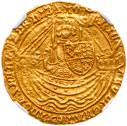 |
Richard II (1377-99), Gold Noble. Tower Mint, type IVa, obverse legend with scallop shell after DI and GRA, pellet on rudder? King standing in ship with upright sword and quartered shield, flag at stern of ship, beaded circle surrounding, RIC ARDx DI*GRA* REXx AnGL' xZx FRAnCxx DnSx hIBx Zx AQ T, rev. R at centre of ornamental cross with lis terminals, crowns over lions in angles, all within a beaded and linear tressure, fleurs in spandrels, legend +IhC'x AVTEm'x TRAnSIEnSxx PERxx mEDIV'x ILLORVxx IBAT, weight 7.55g (Schneider ---; Webb Ware 4a; N.1304; S.1658). Rim a little ragged at upper left of obverse, two small raised die flaws on reverse legend, has been graded and slabbed by NGC as MS61, extremely rare with the scallop shell in legend rather than on rudder of ship, no example in the Schneider collection. Estimated Value $7,500 - UP
NGC Certification 5880656-013. We note this is the only example so far graded by NGC of S.1658 so this piece is top of the population there, however PCGS have graded one example higher. The abbreviated Latin legends translate as on the obverse "Richard by the Grace of God, King of England and France and Lord of Ireland and Aquitaine" and on the reverse "But Jesus, passing through the midst of them, went His way" taken from the Bible. This type of Noble is struck in the style of the subsequent Henry IV type Nobles so must date towards the end of Richard�s reign. The output of gold at London for the last three years of the reign from September of 1396 to October of 1399 amounted to roughly £50,000 worth of gold coins which is a smaller relative output per year than most of the outputs of the preceding reign of Edward III and smaller than the first three years of Richard�s reign.
Ex A H Baldwin, purchased 1st April 2005.
Ex Lord Stewartby Collection part III, Spink Coin Auction, 26th September 2016, lot 922.
View details and enlarged photos
Realized
$7,380 |
|
Lot 3118 |
 |
Henry VI, first reign (1422-61),�Gold Noble of six shillings and eight pence, Calais Mint, Annulet Issue (c.1422-30). King standing in ship with upright sword and quartered shield, flag at stern, annulet by sword arm, lis after King's name, small trefoils stops in abbreviated Latin legend h EnRIC+ DI: GRA': REX: AnGL': Z: FRAnC': DnS: hyB', rev. h at centre, ornate cross with lis terminals, crown over lion in angles, all within beaded and linear tressure of eight arcs, annulet in upper right spandrel, large fleurs in other spandrels, initial mark fleur de lis, annulet stops in abbreviated Latin legend +Ih'C*AVT'o TRAnSIEnSo PERo mEDIVmo ILLORV'o IBAT, weight 6.94g (Schneider 299; N.1415; S.1803, incorrect S. number on NGC holder).�Toned, has been graded and slabbed by NGC as MS61. Estimated Value $5,000 - UP
NGC Certification 5880654-003. We note this is only the fifth example currently to have ever graded at the MS level across both services. The abbreviated Latin legends translate as on the obverse "Henry by the Grace of God, King of England and France and Lord of Ireland" and on the reverse "But Jesus, passing through the midst of them, went His way" taken from the Bible. �As of 1422 the Calais Mint in France reopened after a period of closure since 1404 as there was a requirement for aliens having to pay for their English wool at the Staple Company in English Nobles, compelling them to have their foreign bullion currency converted at the Mint to Nobles. The length of credit extended to such wool buyers was at the same shortened or cut leading to a further influx of bullion which rose to very high levels from 1422-24 with some £60,000 of gold coined there. All in all some £100,000 worth of gold was struck at Calais which weighed some 6,000 pounds.
Ex Clarendon Collection part I, Bonhams, 27th March 2006, lot 494.
View details and enlarged photos
Realized
$9,533 |
|
Lot 3119 |
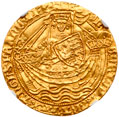 |
Henry VI, first reign (1422-61), Gold Noble of six Shillings and eight pence, Annulet issue (1422-30). York mint, King standing in ship holding sword and shield, annulet by sword arm, lis at stern and after King's name, legend surrounding, h EnRIC'+ DI; GRA; REX: AnGL; Z: FRAnC; DNS; hYB', rev. initial mark lis, h at centre, ornate cross with lis terminals, crown over lion in each angle, within beaded and linear tressure of eight arcs, fleurs in spandrels, annulet in upper right spandrel, beaded circle surrounding, annulet stops in legend, +Ih'C* AVTo TRAnSIEnSo PERo mEDIVmo ILLORV'o IBAT, outer beaded border both sides, weight 6.83g (Schneider 302A; N.1416; S.1804). A touch flat in places both sides, but with an excellent depiction of the King, has been graded by NGC as AU58, a rare coin. Estimated Value $12,500 - UP
NGC Certification 5880656-014. We note this coin is currently the second finest graded at NGC of this variety of the York Mint, PCGS have yet to grade any example of this type of coin S.1804. The York Mint struck gold coins for the first time ever in this reign from 12th August 1423 to 14th August 1424, to a total weight of 2,538 pounds of gold which would have had a face value of circa £42,310. By comparison London Tower Mint issued circa £57,767 face value in the following 12-month period after York ceased striking gold, but by contrast London issued just over £500,000 worth of face value gold in this issue. These York Mint pieces feature a fleur de lis over the stern of the ship and being only struck for a year are quite rare today.
View details and enlarged photos
Unsold |
|
Lot 3120 |
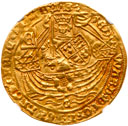 |
Edward IV, first reign (1461-70), Gold "Rose" Ryal of ten shillings, light coinage (1465-70). Coventry Mint, King standing in ship holding sword and shield, C in waves below for Coventry, E on flag at stern, rose on hull, legend and beaded borders surrounding, trefoil stops both sides, initial mark sun on reverse only (1465-66), ED WARD'. DI: GRA'. REX. AnGL'. Z FrnC'. DnS. I.B., rev. rose at centre on sunburst, over cross with floriate and lis terminals, crown over lion in each angle, all within beaded and linear tressure of eight arcs, fleurs in spandrels, beaded circle surrounding, nS of legend struck over Sn, *IhC'. AVT'. TRanSIenS: PER: mEDIvm: ILLORvm. IBAT, weight 7.65g (Schneider 421; N.1551; S.1955). Nice broad striking, weak in parts of legend both sides, has been graded and slabbed by NGC as AU55, a very rare Mint. Estimated Value $12,500 - UP
NGC Certification 5880656-017. We note this is the only example of the Coventry Mint Ryal graded currently by NGC and is therefore top of the population. PCGS have yet to grade an example either at the time of writing. The mint mark of sun was only used from 1465 to 1466 during the first reign of King Edward IV at the Bristol, London and York mints. Unfortunately, only the accounts for London survive from this period at the current time and show a large output of gold of £278,774 in the accounting period 1st September 1464 to 29th September 1466. Judging by the scant amount of survivors of the Coventry Mint in commerce today, the unknown mintage of this provincial mint must have been but a mere fraction of what was produced in London.
Ex Sotheby, 6th May 1981, lot 323.
Ex Thos H Law Collection, Stacks Bowers Ponterio, Auction 176, 13th August 2013, lot 20034.
View details and enlarged photos
Unsold |
|
Lot 3121 |
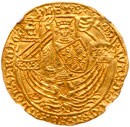 |
Edward IV, first reign (1461-70), Gold "Rose" Ryal of ten shillings, light coinage (1465-70). Norwich Mint, King standing in ship holding sword and shield, mint letter n in waves below for Norwich, E on flag at stern, rose on hull, Latin legend and beaded borders surrounding, trefoil stops both sides, initial mark sun on reverse only (1465-66), ED .WARD'. DI: GRA'. REX. AnGL'. Z FRAnC'. DnS. I.B., rev. rose at centre on sunburst, over cross with floriate and lis terminals, crown over lion in each angle, all within beaded and linear tressure of eight arcs, fleurs in spandrels, beaded circle surrounding, stop between I and B, *IhC'. AVT'. TRAnSIEnS: PER: mEDIVm: ILLORVm. I.BAT, weight 7.65g (Schneider 422; N.1552; S.1956). Nice broad striking, rim a little uneven otherwise a very presentable example, has been slabbed and graded by NGC as MS61, extremely rare. Estimated Value $19,500 - UP
NGC Certification 5845559-004. This coin at the time of writing appears to be the only example of the very rare Norwich Mint Ryal so far graded at NGC or PCGS. The abbreviated Latin legends translate as on the obverse "Edward by the Grace of God, King of England and France, Lord of Ireland" and on the reverse "But Jesus, passing through the midst of them, went His way" taken from the Bible. The English coinage was devalued on 13th August 1464 in response to a decline in the Wool trade, and secondly a general shortage of coinage metal, due to the long-standing value of bullion in England being unchanged since 1412 compared to that in France. Extremely rare gold Nobles were struck in the low output times at the start of the reign until 6th March 1465. The light coinage of the new Ryal at ten shillings face value then commenced with increased output, the devaluation having placed the gold Noble value from six shillings and eight pence up to eight shillings and four pence. To deal with the increased output, branch mints were opened in the cities of York, Bristol, Coventry and Norwich, all opening from July 1465, but output apparently fell away quickly as by 1466 it seems more competitive terms for coining were offered in the Low Countries. The legacy of which is a small number of surviving coins of the branch mints of which Norwich and Coventry are the hardest to come by.
Ex Dix, Noonan and Webb, 28th September 2005, lot 574.
Ex Property of a Gentleman, Mark Rasmussen List number 27, Spring 2015, item C16.
View details and enlarged photos
Unsold |
|
Lot 3122 |
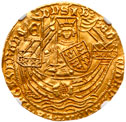 |
Edward IV, first reign (1461-70), Gold "Rose" Ryal of ten shillings, light coinage (1466-67). London Mint, King standing in ship holding sword and shield, ship rigging with three ropes to left, one rope to right, E on flag at stern, rose on hull, trefoil stops both sides, initial mark crown on reverse only (1466-67), ED: WARD' DI' GRA; REX. AnGL'. Z. FRanC.DnS'. I.B'., rev. rose at centre on sunburst, over cross with lis terminals, crown over lion in each angle, all within beaded and linear tressure of eight arcs, fleurs in spandrels, beaded circle surrounding, stop between I and B, IhC; AVT; TRanSIenS; PER mEDIvm; ILLORV. I.BAT, weight 7.70g (Schneider 361/-; N.1549; S.1950). Lightly toned, some red wax residue on reverse, has been graded by NGC as MS63, the finest graded at present of this variety. Estimated Value $7,500 - UP
NGC Certification 5880656-015. We note at the time of writing that this is the highest grade assigned an example of S.1950 for this mint mark at NGC out of 23 examples graded, and is therefore top of the population at both grading services, as PCGS have only graded one example a level below at 62. The obverse legend translates as "Edward by the Grace of God, King of England, Lord of Ireland" and on the reverse "But Jesus, passing through the midst of them, went His way" taken from the Bible. The accounts of gold output for the period of time where the crown mint mark appears alone are missing.
Ex Spink Coin Auction 190, 27th September 2007, lot 537.
View details and enlarged photos
Realized
$16,605 |
|
Lot 3123 |
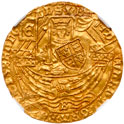 |
Edward IV, first reign (1461-70), Gold "Rose" Ryal of ten shillings, light coinage (1465-70). Bristol Mint, King standing in ship holding sword and shield, B in waves below for Bristol, E on flag at stern, rose on hull, legend and beaded borders surrounding, trefoil stops both sides, initial mark crown on reverse only (1466-69), ED WARD'. DI: GRA'. REX. AnGL'. Z FRAnC'. DnS'. I.B., rev. rose at centre on sunburst, over cross with floriate and lis terminals, crown over lion in each angle, all within beaded and linear tressure of eight arcs, fleurs in spandrels, beaded circle surrounding, IhC'. AVT'. TRAnSIEnS. PER. mEDIVm. ILLORVm: I.BAT, note stop after last I, weight 7.74g (Schneider 419; N.1550; S.1954). Toned, has been graded and slabbed by NGC as MS60 the highest graded piece of this variety and mint. Estimated Value $7,500 - UP
NGC Certification 5880656-016. We note currently that this is the highest graded Bristol Mint Ryal of S.1954 at NGC and that PCGS have yet to grade any examples. The mint mark of crown was only used from 1466 to 1469 during the first reign of King Edward IV at the Bristol, London and York mints. Unfortunately, most of the accounts do not survive from this circa 50 month period at the current time. Accounts at Bristol immediately following this mint mark period do survive however and show a mere £3,201 of gold being struck the year following from 30th September 1469 to 29th September 1470. The next 7 months after are also missing, but the final account over 14 months from 1st May 1471 until the Bristol Mint closure on 23rd July 1472 do survive and show only another £2,638 output of gold. These are very small outputs especially compared to London where known outputs are always five figure sums and often 10 to 20 times more.
Ex Spink Numismatic Circular, July-August 1962, item 6885.
Ex Clarendon Collection, part I, Bonhams, 28th March 2006, lot 596.
View details and enlarged photos
Realized
$10,148 |
|
Lot 3124 |
 |
Henry VIII (1509-47),�posthumous issue under King Edward VI, Gold Crown of the Double Rose of five shillings. Struck in 20 carat crown gold, posthumous coinage (1547-51), first period, Tower Mint I, large crowned rose, crowned H to left, crowned R to right, beaded circle surrounding, Roman style lettering with lozenge stops, initial mark arrow (1547-48) both sides, HENRIC'. 8. RVTILA'. ROS'. SIN'. SPI',�rev.�crowned quartered shield of arms, crowned H to left, crowned R to right, DEI'. GRA'. AGL'. FRA'. Z' HIB'. REX.:, weight 3.10g (Schneider 649; N.1867; S.2395, incorrect S. number on NGC holder).�Toned, has been graded and slabbed by NGC as MS63, the finest graded example of the type. Estimated Value $5,000 - UP
NGC Certification 5880654-004. This coin is currently the highest graded Posthumous issue gold crown at both services and the finest ever graded of this denomination for Henry VIII at NGC. PCGS have graded two earlier and more common gold crowns of differing types of Henry VIII as MS63. Therefore, this coin is currently top of the population report. The abbreviated Latin legends translate as on the obverse "Henry VIII a dazzling rose without a thorn" and on the reverse "by the grace of God, King of England, France, and Ireland". The first phase of the coinage of Edward VI was struck as a posthumous issue of King Henry VIII on account of the debased state the coinage had been left in after costly foreign enterprises, leaving the gold coinage issued at a 20 carat fineness. Peace with France was not concluded till 1550 when the first steps could be taken to restoring the fineness to the coinage starting with the surrender of Boulogne for the payment of 400,000 ecus of gold (about £90,000). The gold Crown offered herewith was issued at a time when three mint locations were at work in the London area, Tower I and Tower II mints and the other at Southwark. The arrow mint mark was used at Tower I seemingly from the 5th April 1547 until 24th January 1549 when the lis mark comes into sole use; a period in which some £240,000 of crown gold was struck at this mint.
Ex Mark Rasmussen Numismatist, Surrey, list number 31, item 54.
View details and enlarged photos
Realized
$3,936 |
|
Lot 3125 |
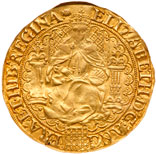 |
Elizabeth I (1558-1603), fine Gold Sovereign of thirty shillings, sixth issue (1583-1600). Full facing robed figure of Queen seated on large throne, lis headed pillar either side, throne back of pellets in hatching, five small pellets up each side of throne back, portcullis below Queen, tressure and beaded border surrounding, Latin legend and outer beaded border on both sides, initial mark tun (1592-93), +ELIZABETH D; G; ANG; FRA; ET. HIB; REGINA. rev. quartered shield at centre of ornate rose, beaded circle surrounding, +A; DNO' FACTV; EST. ISTVD. ET. EST. MIRAB' IN OCVL; NRS; weight 15.16g (Brown and Comber A26; Schneider 783; N.2003; S.2529). Weak part on face and shoulders, otherwise quite well struck and crisp around legends, has been graded and slabbed by NGC as AU55, becoming hard to find, very desirable. Estimated Value $25,000 - UP
NGC Certification 5880656-018.We note currently at time of writing this is the second highest graded Elizabeth I fine Sovereign of this mint mark across both services. The abbreviated Latin legend translates as on obverse "Elizabeth by the Grace of God, Queen of England, France and Ireland" and on the reverse "This is the Lord's doing and it is marvellous in our eyes", a Psalm from the Bible. The fine gold Sovereign of Elizabeth I was a highly respected coin at the time, and was famed in the acting world of the time of William Shakespeare, as the coin of choice to be honoured with should the Queen attend a performance personally. Traditionally the Queen would honour the playwright and the star of the show with her favour reflected in the presenting of a fine gold Sovereign. We have such evidence of this in the will of the Gentleman Actor Augustine Phillips of Mortlake Surrey who was one of the first to rise to such a social status in his profession. From his will dated 13th May 1605 we can see fine gold Sovereign presented described thus "I give and bequeath to my fellow William Shakespeare a XXxs piece in gould, To my fellow Henry Condell one other xxxs piece in gould." Such a coin of honour being highly revered and not to be spent in the lifetime of the recipient. The usage of mint mark tun for fine gold can be assume to have started production around the 1st February 1591/2 until the 10th June 1593 which is a known date from the surviving pyx trial records for the end of the production of the fine Sovereign, before giving way to the gold Pound in the next issue. It is estimated that some £12,000 worth of fine gold coins were struck for this mark in this issue which includes the gold Angel and its fractions.
Purchased from A H Baldwin and Sons, February 2006.
View details and enlarged photos
Realized
$35,670 |
|
Lot 3126 |
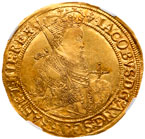 |
James I (1603-25), Gold Sovereign of twenty shillings, first coinage (1603-04). Struck in crown gold of 22 carat fineness, second crowned armoured half-length figure of King right, holding orb and sceptre, Latin legend and beaded borders surrounding, initial mark lis (23rd May to 10th November 1604) both sides, IACOBVS. D; G; ANG; SCO; FRAN; ET. HIB; REX., rev. crowned quartered shield of arms, I to left and R to right, Latin legend and beaded borders surrounding, EXVRGAT. DEVS. DISSIPENTVR. INIMICI., weight 11.09g (Schneider 2; N.2066; S.2609). Lightly toned, with a well-defined portrait, has been graded and slabbed by NGC as AU58, very rare. Estimated Value $40,000 - UP
NGC Certification 5880656-019. We note that this is currently the only example of the second bust Sovereign graded at both services and that it is also the finest of all the James I Sovereign thus far graded, therefore top of the entire population. The first indenture for coinage in the reign is dated 21st May 1603 and allows for a "crown" gold 22 carat Sovereign of twenty shillings, the only fine gold being the Angel and its fractions. The short-lived first issue features a legend mentioning England and Scotland separately, which only occurs in the first coinage of this King before he styles himself King of Great Britain from the second coinage onwards. The second bust mint mark lis coinage is a short-lived issue within this coinage only being issued for four and a half months, but alas there is no breakdown of output between the first mint mark of thistle and that of the lis. What we do know is only £31,609 of crown gold was made for all crown gold denominations across the first coinage which is only a small amount when compared with other later outputs in the other coinages. The abbreviated obverse legend translates as "James, by the Grace of God, King of England, Scotland, France and Ireland" with the reverse as "Let God arise and let his enemies be scattered.".
Ex James O'Byrne, Christies, 18th June 1963, lot 39.
Ex David Dupree Collection, purchased privately by Spink 1989.
Ex Thos. Law, Stacks Bowers Ponterio, 13th August 2013, lot 126.
View details and enlarged photos
Realized
$47,970 |
|
Lot 3127 |
 |
James I (1603-25), fine Gold Angel of eleven shillings, second coinage (1604-19). St Michael slaying dragon right, Latin legend and beaded border surrounding on both sides, initial mark trefoil (1613) both sides, struck over tower over mullet on obverse, struck over tower on reverse, pellet stops, IACOBVS. D' G'. MAG'. BRIT'. FRA'. ET. HI'. REX., rev. flat decked ship sailing, no bowsprit, large quartered shield at centre, I to left of mast, cinquefoil to right, beaded circles and legend surrounding.A. DNO. FACTVM. EST. ISTVD., weight 4.64g (Schneider -; N.2081; S.2615). Lightly toned, fully round, especially rare in unpierced state, we note that there is no example of this mint mark present in the Schneider Collection for this denomination, has been graded and slabbed by NGC as MS63. Estimated Value $12,500 - UP
NGC Certification 5880656-021.We note that currently this is the finest graded gold Angel of King James I across both services, being four grades finer than the next contender and top of the population not just of the variety but for the denomination in this reign. The output of fine gold for this period was a mere £1,925, which covered four denominations from the impressive large gold Ryal to the small Half Angel. The Angel was struck quite sparingly as evidenced by the reuse of the obverse and reverse dies from previous mint mark periods. The obverse seems to have started life as a mint mark Mullet piece dating to 1611-12; it was then over-stamped with mint mark Tower for the period (1612-13) and then again with Trefoil for the remainder of 1613, good longevity for this time. The reverse was also used for mint mark Tower then over-stamped for use as mint mark Trefoil.
Ex James Perley Storer, Spink Coin Auction 111, 21st November 1995, lot 162.
Ex A Collection of Angels, Half-Angels and Quarter-Angels, A. H. Baldwin, Fixed Price List, Summer 2015, item ANG015.
Ex A. H. Baldwin, Fixed Price List, Summer 2017, item 134.
View details and enlarged photos
Realized
$17,835 |
|
Lot 3128 |
 |
James I (1603-25), Gold Double Crown, second Coinage (1604-19). Fifth crowned bust right within beaded circles and legend, initial mark plain cross (1618-19), struck over crescent on reverse.IACOBVS; D;G; MA; BRI; FRA; ET. HI; REX., rev. crowned quartered shield of arms, I to left, R to right.HENRICVS. ROSAS. REGNA. IACOBVS., weight 5.04g (Schneider 41; N.2089; S.2623). Golden yellow tone on a full round flan, some slight striking striations, with a nice portrait, the penultimate mint mark of the coinage, has been slabbed and graded by NGC as AU55. Estimated Value $3,000 - UP
NGC Certification 5880656-020. We note this is currently the only example of this mint mark plain cross S.2623 graded at both services and therefore top of the population. The abbreviated Latin legends translate as on the obverse "James by the Grace of God, King of Great Britain, France and Ireland" and on the reverse as "Henry united the Roses, James the Kingdoms", a legend that is exclusive to this reign. The original surviving Mint accounts show that £148,755 of 22 carat crown gold was struck for the period 1st April 1618 until 31st March 1619.
Ex Mark Rasmussen Numismatist, list 23, Summer 2012, item 51.
Ex G. W. Trow Collection, Classical Numismatic Group, Triton XXIII, 14th January 2020, lot 1384.
View details and enlarged photos
Realized
$5,658 |
|
Lot 3129 |
 |
Charles I (1625-1649), Gold Double Crown or Half-unite of ten shillings, Nicholas Briot's first milled coinage (1631-32). Crowned draped bust left with jewelled crown, value .X. behind, all within inner beaded circle, initial mark daisy with B to left, pellet stops in Latin legend and outer toothed border surrounding, CAROLVS. D:G. MAG. BRITAN. FRAN. ET. HIB. REX, rev. inverted die axis, crowned garnished quartered shield, crowned C and lozenge to left, crowned R and lozenge to right, inner beaded circle surrounding, lozenge stops in Latin legend and outer toothed border surrounding, initial mark .B. to left of crown, CVLTORES. SVI. DEVS. PROTEGIT, weight 4.50g (Schneider 279; Brooker 710; N.2295; S.2720). Slight adjustment marks in places both sides, light red pleasant tone, has been graded and slabbed by NGC as AU58, rare. Estimated Value $22,500 - UP
NGC Certification 5880656-023. We note that currently this coin is top of the graded population of Briot Double Crowns Spink 2720 across both grading services. The abbreviated Latin legends translate as on the obverse "Charles by the Grace of God, King of Great Britain, France and Ireland" and on the reverse "God protects His worshippers." Nicholas Briot the Engraver general to the mints of France, introduced his mechanised mill press to the Tower Mint in 1631, and produced at the 22 carat standard two small issues of gold coins in 1631 and 1638, concurrent with the regular hammered issues. The milled issues were engraved to a very fine quality by Briot, like the coin offered here. Briot had gained the King's favour in 1626 after having moved to England in 1625, the King wanting to improve the artistic merit of the nation's coinage, which led to Briot's official appointment as mint engraver in 1634.
Ex William Laud Raynes, Glendining, 15th February 1950, lot 261.
Ex Spink Coin Auction 215, 4-5th December 2012, lot 47.
View details and enlarged photos
Realized
$27,675 |
|
Lot 3130 |
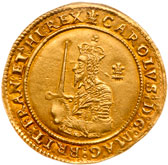 |
Charles I (1625-49), Gold Triple-Unite of three Pounds, 1642. Oxford Mint, half-length crowned armoured figure of King left, holding sword and palm branch, Oxford plumes in field behind, all within beaded circle, Latin legend and outer toothed border surrounding, initial mark Oxford plumes, CAROLVS: D: G: MAG: BRIT: FRAN: ET: HI: REX, rev. abbreviated Latin Declaration inscription in three wavy lines at centre, RELIG: PROT / LEG: ANG / LIBER: PAR, date below, three Oxford plumes over .III. value above, Latin legend commences upper left within beaded and toothed border surrounding, initial mark five pellets, :EXVRGAT: DEVS: DISSIPENTVR: INIMICI: weight 27.08g (Beresford-Jones dies III / S2; Schneider 286; N.2381; Brooker 832; S.2724). Struck on a full broad flan, a little weak on elbow and hands, with usual inherent raised die flaws, almost extremely fine, has been graded and slabbed by NGC as AU58. Estimated Value $100,000 - UP
NGC Certification 5845559-006. This coin recently featured in the You Tube video "The Amazing Triple Unite!" by the British coin channel "Numistacker." At the time of writing only 45 gold Triple Unites have thus far been graded across both services which are then broken down by variety. For Spink 2724 eleven pieces have been graded at NGC and two at PCGS both of which are lower in grade than this coin. Of the 11 graded at NGC only two are finer graded making this coin currently the third highest graded of the 1642 dated S.2724 variety. The abbreviated obverse legend translates as "Charles, by the Grace of God, King of Great Britain, France and Ireland". The abbreviated reverse Declaration translates as "The religion of the Protestants, the Laws of England, the Liberty of Parliament". The outer reverse legend translates as "Let God arise and let his enemies be scattered". The gold Triple Unite represents the largest hammered gold denomination ever produced in the English series of coinage at a face value of Three Pounds. Such coins were produced at a time of duress, when the King had moved his Capital from London after the Battle of Edgehill, to the Royalist Universities of the City of Oxford, where he made a state entrance on 29th October 1642. The King lived at Christ Church, with the Queen installed at Merton; the Royalist Parliament met in the Upper Schools and Great Convocation House; the Privy Council at Oriel; and the Mint worked at New Inn Hall from the 3rd January 1642/3 but the records of output have not survived to the present day. These magnificent gold coins were struck for only three dates, 1642, 1643 and 1644 with some variation as there are 24 different varieties of obverse and reverse across these three dates, plus an extremely rare 1642 piece struck in Shrewsbury. Today, it is estimated the 25 different combinations exist in a mere surviving sample of some 250 pieces. When the Triple Unite was introduced as currency it was more than double the value of any previous English coin produced, and would have been seen as a magnificent piece of propaganda against the Puritan cause, to show that though the King had moved from London, Oxford was a rich alternative City. Perhaps the King was inspired by similar large extremely rare Scottish coins produced some 70 years earlier by his Father, King James VI of Scotland in 1575-6. The King had introduced the first regular newspaper printed in Oxford the "Mercurius Aulicus" from the 1st January 1642/3 (1642 old calendar style), and the introduction of the new Triple Unite as currency is featured in the edition produced around the 18th February 1642/3, and features a woodcut illustration of the new denomination (dies 1/S1 combination). This is thought to be the first ever illustration of a current coin of the realm in contemporary print. As the new year in the old calendar style commenced on the 25th March this means all the 1642 dated coins were produced in only a very limited time from mid-February to probably April at latest when 1643 dated pieces were no doubt produced. It seems the issue of this great coin ceased with the great fire of Oxford as reported in the same newspaper of 6th October 1644, as there are only three reverse types known of 1644.
Ex Ira and Larry Goldberg, Hollywood, USA, 29th May 2006, lot 1202.
View details and enlarged photos
Unsold |
|
Lot 3131 |
 |
Charles I (1625-49), Gold Unite of Twenty Shillings, Oxford Mint, 1643. Crowned armoured half-length figure of King left, holding upright sword and palm branch, value XX behind, Latin legend and beaded borders surrounding, initial mark Oxford plumes, CAROLVS. D: G. MAG: BR: FR: ET: HIBER: REX, rev. abbreviated Latin Declaration inscription on three line scroll at centre, RELIG: PROT / :LEG: ANG: / LIBER: PAR, date below, three Oxford plumes above, Latin legend commences upper left within beaded and toothed border surrounding, two pellets at end of legend, EXVRGAT: DEVS: DISSIPENTVR: INIMICI:, weight 9.03g (Beresford-Jones dies VIII / 13; Schneider 318; N.2389; Brooker 850; S.2734). Toned, quite well struck especially on portrait with just a few superficial weaknesses in legend and sword blade, has been graded and slabbed by NGC as AU55, with a good pedigree. Estimated Value $19,500 - UP
NGC Certification 5880656-022. We note currently that this is the top of the population for a 1643 dated Unite of Oxford at NGC and finer than all the 1643 dated Unites graded at PCGS. The abbreviated obverse legend translates as "Charles, by the Grace of God, King of Great Britain, France and Ireland". The abbreviated reverse Declaration translates as "The religion of the Protestants, the Laws of England, the Liberty of Parliament". The outer reverse legend translates as "Let God arise and let his enemies be scattered." The records of output at the Oxford Mint have not unfortunately passed down to the present day but there are a number of different dies used across the Unite series from 1642 to 1646 inclusive as detailed in the artlcle "The Oxford Mint 1642-6" by R. D. Beresford-Jones, British Numismatic Journal, Volume 28, 1955, pages 604-619.
Ex Captain Ronald D. Wills, Glendining, 6th December 1938, lot 93.
Ex Dr John Cosmo Stuart Rashleigh, part III, Glendining, 10th June 1953, lot 61.
Ex Heritage New York Signature Sale, 3rd January 2016, lot 31232.
Ex Dr Jonathan P Rosen, CNG Triton XXI, 9th January 2018, lot 1456.
View details and enlarged photos
Realized
$27,675 |
|
Lot 3132 |
 |
Charles I (1625-1649). Silver Halfcrown, 1642, Oxford Mint. King on horseback left, holding sword upright, without groundline, Rev. Three Oxford plumes above Declaration, date below, mint mark, plume, weight 14.82g (S.2953; N.2412). Double striking in legend, as struck with fully struck horseman, toned with considerable mint brilliance. About Uncirculated. Estimated Value $2,000 - UP
View details and enlarged photos
Realized
$3,690 |
|
Lot 3133 |
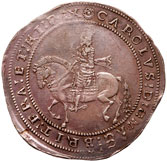 |
Charles I (1625-1649). Silver Crown, Truro Mint (1642-43). King on horseback left, sash flies out in two loose ends, Rev. Oval garnished shield, mint mark rose, weight 30.04g (S.3045; N.2531; Dav-3764). Attractive antique light toning. In NGC holder graded AU 50. Estimated Value $1,500 - UP
NGC Certification 4930815-056.
The William Oldknow Collection.
View details and enlarged photos
Realized
$2,399 |
|
Lot 3134 |
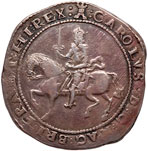 |
Charles I (1625-49). Silver Crown, 1645. Exter Mint. King on horseback left with raised sword and flowing sash, mint mark Castle above, legend; CAROLVS D G MAG BRI FRA ET HI REX. Rv. Oval garnished shield. Legend; CHRISTO AVSPICE REGNO followed by date, weight 28.83g (S.3062; N.2561). In NGC holder graded AU 50. Estimated Value $1,000 - UP
NGC Certification 4930819-002.
The William Oldknow Collection.
View details and enlarged photos
Realized
$2,214 |
|
Lot 3135 |
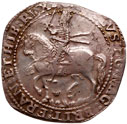 |
Charles I (1625-1649). Silver Halfcrown, Worcester Mint, circa 1644-5. King on horseback left, holding sword upright, horse's tail falls straight down, small W above grass below, CAROLVS : D G : MAG : BRIT : FRAN : ET : HIB REX, Rev. Large crowned square-topped garnished shield, CHRISTO AVSPICE REGNO, mint mark helmet, weight 14.23g (S.3096; N.2587). Irregular flan, antique light violet tone. Rare. In NGC holder graded AU 58. Estimated Value $2,500 - UP
NGC Certification 4930819-001
As the tensions between Charles I and the Long Parliament increased in 1642, the cathedral town of Worcester in Worcestershire was divided in their support for the Royalist and Parliamentarian causes. The town council preferred Parliament, the Worcestershire landed gentry preferred the king, and the general townsfolk preferred to steer clear of both. However, when the English Civil War broke out on 22 August 1642, the gentry, who largely controlled the muster of the local Trained Bands (militia forces), compelled Worcester to declare for the Royalists. As it turned out, this was a disastrous decision for the town.
Due to the strategic position of Worcestershire for the Royalists in their struggle against the Parliamentarian forces in Birmingham, Warwickshire, and Gloucestershire, Worcester immediately had a military garrison imposed on it. The town was forced to billet and feed the Royalist forces stationed there while the cathedral was used to store munitions. The cathedral was seriously damaged in September-October 1642, after Parliamentarian forces under the Earl of Essex briefly seized the town before they were forced to withdraw. In the years that followed, Worcester suffered crushing taxation, the forcible impressment of its men into the Royalist army, and the destruction of its suburbs in order to make the town proper more easily defensible.
By the time this halfcrown was struck in 1644-1645, probably to finance the garrison and the ongoing work to improve the town�s fortifications, the Parliamentary noose was tightening around the Royalist forces, which only retained control of parts of the Westcountry and Wales. At last, following the major Parliamentarian victory at Stow-on-the-Wold (21 March 1646), hope faded for the Royalist cause and Worcester faced attack by 5,000 troops of the Parliamentarian.
The William Oldknow Collection.
View details and enlarged photos
Realized
$6,458 |
|
Lot 3136 |
 |
Charles I (1625-49). Silver Halfcrown, Salopia (Shrewsbury) Mint circa 1644. Mint mark, lis, King on horseback left with raised sword, horse with mane blown forward, Rev. Small crowned oval shield, weight 14.52g (S.3124; N.2605). Very rare. In NGC holder graded AU 58. Estimated Value $4,000 - UP
NGC Certification 4930815-055
This important market town of Shrewsbury in Shropshire had been a staunch Royalist stronghold since the outbreak of the Civil War in 1642 and frequently served as a base of operations for Charles� skilled cavalry commander, Prince Rupert, the Duke of Cumberland. The coin may very well have been struck to finance Rupert�s 1644 campaign against the Parliamentarian forces in Northern England, which began with a muster of the Royalist army at Shrewsbury in May. Unfortunately, despite some initial successes, Rupert suffered a major defeat at the Battle of Marston Moor on 2 July, after which the North was completely lost to the Royalists. The Parliamentarian forces failed to immediately capitalize on their victory, however, and Shrewsbury remained a key Royalist supply depot until 22 February 1645, when a Parliamentary sympathizer in the town opened St. Mary�s Water Gate (subsequently renamed Traitor�s Gate) and permitted troops under Thomas Mytton to enter. The capture of Shrewsbury was a great coup for the Parliamentarian cause, as it brought the final defeat of Charles I much closer. Nevertheless, the victory was marred by Mytton�s implementation of the Long Parliament�s Ordinance of No Quarter, which decreed summary execution for Irishmen captured while fighting in support of the English king. In revenge for the Irish captives killed at Shrewsbury, Prince Rupert ordered the execution of Parliamentarian captives held at Oswestry.
The William Oldknow Collection.
View details and enlarged photos
Realized
$7,995 |
|
Lot 3137 |
 |
Commonwealth (1649-60), Gold Crown of five shillings, 1649. Variety without stops by mint mark or value, English shield within laurel and palm branch, legends in English language, initial mark sun, THE. COMMONWEALTH. OF. ENGLAND, rev. English and Irish shields, value V above, beaded circle and legend surrounding, date at top, legend surrounding.GOD. WITH. VS., weight 2.19g (cf. Schneider 357; N.2719; S.3212). With pleasing copper red tone, the first date for the denomination, has been graded by NGC as AU58 and is currently the joint highest graded example at both services, a rare date. Estimated Value $17,500 - UP
NGC Certification 5880621-006. We note at the time of writing that there are only two examples graded dated 1649 at both services. This is the smallest denomination gold coin of the Commonwealth, with all hammered coins of this period being the first British coins to have legends in plain English. The accounting periods of this time period were long and all the gold output is known only as a total over a 30 month period from 16th May 1649 until Christmas Day 1651, which amounted to £34,505.
Ex Spink Coin Auction, 26th June 2013, lot 666.
View details and enlarged photos
Unsold |
|
Lot 3138 |
 |
Commonwealth (1649-60), Gold Half-Unite or Double Crown of ten shillings, 1651. English shield within laurel and palm branch, legends in English language, initial mark sun.THE. COMMONWEALTH. OF. ENGLAND., rev. English and Irish shields, value .X. above, beaded circle and legend surrounding, date at top.GOD. WITH. VS., weight 4.50g (Schneider 350; N.2717; S.3210). Attractively toned, with underlying brilliance and well centred, has been graded and slabbed by NGC as MS61. Estimated Value $15,000 - UP
NGC Certification 5880621-004. We note at the time of writing that there are only three examples graded higher than this piece across both services. This is the mid-denomination gold coin of the Commonwealth, with all hammered coins of this period being the first British coins to have legends in plain English. The accounting periods of this time period were long and all the gold output is known only as a total over a 30 month period from 16th May 1649 until Christmas Day 1651, which amounted to £34,505.
Ex St James Auction 22, 1st October 2012, lot 425.
View details and enlarged photos
Unsold |
|
Lot 3139 |
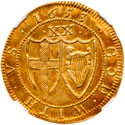 |
Commonwealth (1649-60), Gold Unite of twenty shillings, 1653. English shield within laurel and palm branch, legends in English language, initial mark sun.THE. COMMONWEALTH. OF. ENGLAND., rev. English and Irish shields, value .XX. above, beaded circle and legend surrounding, date at top, legend surrounding.GOD. WITH. VS., weight 9.16g (Schneider 341; N.2715; S.3208). Toned with an attractive red colour, has been slabbed and graded by NGC as AU58. Estimated Value $12,500 - UP
NGC Certification 5880543-002. At the time of writing this coin is currently the fifth highest graded of fifteen that have been graded by this service; PCGS have only graded seven pieces, one of which is higher. All gold coins of this period are struck in 22 carat gold and are the first British coins to have legends in plain English. The output of gold at this time in the accounting period of 1652 until November 1653 was the highest of the Commonwealth period at £38,010 worth. The output at this time was boosted by the capture of a large bullion treasure from the Spanish mainly of silver with some gold which boosted production by a quarter in this period. For further reading about "Cromwell�s Treasure" see the new book published by Spink 2020 "The Metal in Britain�s coins by Graham Birch, pages 94-100. x.
Ex William Laud Raynes, Glendining, 15th February 1950, lot 261.
Ex Spink Coin Auction 215, 4-5th December 2012, lot 47.
View details and enlarged photos
Realized
$13,530 |
|
Lot 3140 |
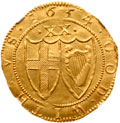 |
Commonwealth (1649-60), Gold Unite of twenty shillings, 1654. Date with 4 struck over 3, English shield within laurel and palm branch, legends in English language, initial mark sun.THE. COMMONWEALTH. OF. ENGLAND., the letter G struck over a retrograde D, rev. English and Irish shields, value .XX. above, beaded circle and legend surrounding, date at top, legend surrounding.GOD. WITH. VS., weight 9.01g (cf.Schneider 342; N.2715; S.3208). Lightly toned, has been graded and slabbed by NGC as MS63, the finest graded of the date, very rare indeed. Estimated Value $17,500 - UP
NGC Certification 5880656-024. We note this 1654 dated Unite is currently the finest and top of the population for this rare date across both services. The coin also ties with the finest graded Commonwealth Unites at PCGS which has examples of the much more common dates of 1651 and 1653 in the same high grade. All gold coins of this period are struck in 22 carat gold and are the first British coins to have legends in plain English. In our experience for every 25 gold Unites of the Commonwealth you see for sale, only 2 will be of the date 1654. To find the variety with the overdate and the retrograde D in legend is perhaps an even greater ratio of rarity. The output of gold at this time is broken down no further than a four year accounting period from December of 1653 until November of 1657 with a gold output at the Mint of a mere £23,111.
Ex St James Auction 7, 8th February 2008, lot 170
Ex Dr Paul Broughton Collection, Spink Coin Auction 235, 22nd March 2016, lot 470.
Ex CNG Review, Summer 2016, item 431570.
Ex Jonathan P Rosen Collection, CNG, Triton XXI, 9th January 2018, lot 1465.
View details and enlarged photos
Realized
$18,450 |
|
Lot 3141 |
 |
Oliver Cromwell (d.1658), Silver Halfcrown, 1658. Laureate and draped bust left, abbreviated Latin legend and toothed border surrounding, OLIVAR. D.G.R.P. ANG. SCO. ET. HIB &c PRO, rev. crowned quartered shield of arms of the Protectorate, date above, Latin legend and toothed border surrounding, PAX QVÆRITVR BELLO, edge inscribed in raised letters, +.HAS. NISI. PERITVRVS. MIHI. ADIMAT. NEMO. weight 15.07g (N.2746; Bull 252; ESC 447; S.3227A). Attractively toned, with mint bloom and underlying brilliance, one hairline on neck, a pleasing extremely fine, reverse good extremely fine and highly desirable, has been graded and slabbed by PCGS as MS62. Estimated Value $7,500 - UP
PCGS Certification 34313123. We note at the time of writing that 65 examples of the 1658 Halfcrown have been graded by both services and only 14 are graded finer than this piece. The abbreviated Latin legends translate as "Oliver by the Grace of God, Protector of the Republic of England, Scotland and Ireland," and on the reverse "Peace is sought by war" and additionally on the edge "Let no one remove these from me under penalty of death."
Ex Spink Coin Auction, 6th October 2004, lot 588.
View details and enlarged photos
Unsold |
|
Lot 3142 |
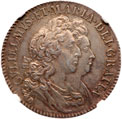 |
William and Mary (1688-94), Silver Halfcrown, 1691. Conjoined laureate and draped busts right, Latin legend and toothed border surrounding, GVLIELMVS. ET. MARIA. DEI. GRATIA, rev. crowned cruciform shields, Lion of Nassau at centre, date surrounding, WM monogram in angles, Latin legend and toothed border surrounding, MAG. BR. FR. ET HI. REX. ET REGINA. edge inscribed in raised letters.+.DECVS. ET. TVTAMEN. ANNO. REGNI. TERTIO.+. weight 14.90g (Bull 850; ESC 516; MCE 798; S.3436). Some light adjustment marks at centre on busts, some light toning, has been graded and slabbed by NGC as MS61, by far the finest graded. Estimated Value $7,500 - UP
NGC Certification 5880623-005. We note at the time of writing that NGC have graded only 7 pieces of this date and this coin is a full 7 grades higher than the next coin down the scale. Looking at PCGS they have only graded 4 pieces and the nearest is 6 grades below this piece. The Latin legends translate as on the obverse "William and Mary, by the grace of God" and on the reverse "King and Queen of Great Britain, France and Ireland" additionally on the edge "An ornament and a safeguard, in the third year of the reign".
Ex James Fox Collection, Classical Numismatic Group, Auction 94, 18th September 2013, lot 1967.
View details and enlarged photos
Realized
$10,763 |
|
Lot 3143 |
 |
William III (1694-1702), Silver Crown, 1696. Third laureate and draped bust right, legend and toothed border surrounding, GVLIELMVS. III. DEI. GRA. rev. crowned cruciform shields, Lion of Nassau at centre, early harp, date either side of top crown, Latin legend surrounding MAG. BR. FRA. ET. HIB. REX. edge inscribed in raised letters and dated, +.+.DECVS. ET. TVTAMEN.ANNO. REGNI. OCTAVO. (Bull 1004; ESC 94; S.3472). Toned, a little weakly struck at the breastplate which helps define the third bust, extremely fine, has been graded and slabbed by NGC as MS62 and incorrectly defined on the label with an ESC reference to the first bust. Estimated Value $3,500 - UP
NGC Certification 2033803-005. The third bust type is defined by the straight breastplate on the chest and far fewer of this type have been graded by the services than the more common first bust. At the time of writing PCGS have graded 16 third bust pieces and NGC have only graded 10. Of the 26 graded, only five are finer graded than the 62 level. The Latin legends translate as on the obverse "William III by the Grace of God" and abbreviated on the reverse as "King of Great Britain, France and Ireland." and additionally on the edge "An ornament and a safeguard, in the eighth year of the reign."
View details and enlarged photos
Unsold |
|
Lot 3144 |
 |
George I (1714-27), Gold Quarter Guinea, 1718. Laureate head right, Latin legend and toothed border surrounding, GEORGIVS. D.G. M.B.R. FR. ET. HIB. REX. F.D., rev. crowned cruciform shields, incorporating the Arms of Hanover, sceptres in angles, garter star at centre, date either side of top crown, BRVN ET. L. DVX S.R.I.A.TH ET. EL., edge diagonally grained (MCE 277; S.3638). Lightly toned has been graded and slabbed by NGC as MS62. Estimated Value $1,250 - UP
NGC Certification 3395004-013. At the time of writing we note that 156 examples of the 1718 Quarter Guineas have been graded across both services of which only 40 are finer than this piece. The abbreviated Latin legends translate as on the obverse "George by the Grace of God, King of Great Britain, France and Ireland, Defender of the Faith" and on the reverse as "Duke of Brunswick and Luneberg, High Treasurer and Elector of the Holy Roman Empire."
View details and enlarged photos
Realized
$1,599 |
|
Lot 3145 |
 |
George I (1714-27), Gold Half-Guinea, 1725. Second older laureate head right, Latin legend and toothed border surrounding, GEORGIVS D. G. M. BR. FR. ET. HIB. REX. F.D, some stops weak or absent both sides, rev. crowned cruciform broad shields, incorporating the Arms of Hanover, ornamental sceptres in angles, garter star at centre, date either side of top crown, Latin legend and toothed border surrounding.BRVN ET. L. DVX S.R.I.A.TH ET. EL. edge obliquely grained, weight 4.21g (MCE 274; S.3637). Toned, practically extremely fine, has been graded and slabbed by NGC as MS61. Estimated Value $3,750 - UP
NGC Certification 5880615-004. The Latin legends translates as on the obverse "George, by the grace of God, King of Great Britain, France and Ireland, Defender of the Faith" and on the reverse "Duke of Brunswick and Luneberg, High Treasurer and Elector of the Holy Roman Empire." The lowest calendar year output of gold coinage in the reign of George I was for the year 1725 at a total production of £58,360 worth of Guineas and Half-Guineas.
View details and enlarged photos
Realized
$4,428 |
|
Lot 3146 |
 |
George I (1714-27), Gold Guinea, 1726. Fifth laureate head right, legend and toothed border surrounding, GEORGIVS D G M BR FR. ET HIB REX. F.D, some stops absent, rev. crowned cruciform broad shields, incorporating the Arms of Hanover, ornamental sceptres in angles, garter star at centre, date either side of top crown, legend and toothed border surrounding.BRVN ET L. DVX S.R.I.A.TH ET. EL., edge obliquely grained, weight 8.40g (Schneider 549; MCE 261; S.3633). Toned with a few light surface marks, has been slabbed and graded by NGC as MS61. Estimated Value $5,000 - UP
NGC Certification 5880617-020. We note currently that there are 50 records of coins graded across both services of which only twelve are graded finer.The abbreviated Latin legends translate as on the obverse "George by the Grace of God, King of Great Britain, France and Ireland, Defender of the Faith" and on the reverse as "Duke of Brunswick and Luneberg, High Treasurer and Elector of the Holy Roman Empire." For the calendar year 1726, £872,963 worth of gold was produced into coin at the mint.
View details and enlarged photos
Realized
$7,073 |
|
Lot 3147 |
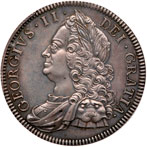 |
George II (1727-60), Silver Proof Crown, 1746. Older laureate and draped bust left, Latin legend and toothed border surrounding, GEORGIVS.II. DEI.GRATIA., rev. crowned cruciform shields, nine strings to Irish harp, garter star at centre, date either side of top crown, Latin legend and toothed border surrounding, M.B.F.ET. H.REX. F.D.B. ET.L.D.S.R.I. A.T ET.E., edge inscribed in raised letters of inverted orientation to obverse, *DECVS. ET. TVTAMEN. ANNO. REGNI. VICESIMO (Bull 1669 R; L&S 7; ESC 126; C&R 807 R; S.3690; KM.585.2). Attractively toned, just a few spots and marks, practically as struck, has been graded and slabbed by PCGS as PR63. Estimated Value $19,500 - UP
PCGS Certification 616820.63/36046643.The abbreviated Latin legends translate as on the obverse "George the Second by the Grace of God, King of Great Britain, France and Ireland, Defender of the Faith" and on the reverse as "Duke of Brunswick and Luneberg, High Treasurer and Elector of the Holy Roman Empire."
View details and enlarged photos
Unsold |
|
Lot 3148 |
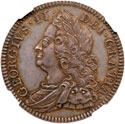 |
George II (1727-60), Silver proof Halfcrown, 1746. Older laureate and draped bust left, Latin legend and toothed border surrounding, GEORGIVS. II. DEI. GRATIA., rev. crowned cruciform shields, garter star at centre, date either side of top crown, M.B.FE. ET. H. REX. F.D. B.ET. L. D. S. R. I. A. T ET. E., edge inscribed in raised letter and dated, DECVS. ET. TVTAMEN. ANNO. REGNI. VICESIMO., weight 15.07g (Bull 1691; ESC 608; S.3696). Attractively toned, has been slabbed and graded by NGC as PF65+ the only coin in this grade. Estimated Value $7,500 - UP
NGC Certification 5880649-001. At the time of writing we note looking across both services that there are 53 coins graded of which this coin is finer than any of the 17 graded by PCGS and regarding NGC only four pieces have graded half a step higher. The Latin legends translate to on obverse "George II by the Grace of God" continuing on the reverse in abbreviated Latin which if in shown in full reads "Magnae Britanniae Franciae et Hiberniae Rex Fidei Defensor Brun et Lunebergen-sis Dux, Sacri Romani Imperii Archi-Thesaurius et Elector" and translates as "King of Great Britain, France and Ireland, Defender of the Faith, Duke of Brunswick and Luneberg, High Treasurer and Elector of the Holy Roman Empire."
View details and enlarged photos
Realized
$6,765 |
|
Lot 3149 |
 |
George II (1727-60), Silver Proof Shilling, 1746. Older laureate and draped bust left, legend and toothed border surrounding, GEORGIVS. II. DEI. GRATIA. rev. crowned cruciform shields, garter star at centre, date either side of top crown, M.B.FE. ET. H. REX. F.D. B.ET. L. D. S. R. I. A. T ET. E. (Bull 1727; ESC 1208; S.3704). Scratches on slab holder. Attractively toned has been slabbed and graded by NGC as PF64. Estimated Value $5,000 - UP
NGC Certification 1877409-006. At the time of writing we note that both services have graded a total of 39 examples of the 1746 proof shilling of which only nine are finer graded than this piece. The abbreviated Latin legends translate as on the obverse "George the Second by the Grace of God, King of Great Britain, France and Ireland, Defender of the Faith" and on the reverse as "Duke of Brunswick and Luneberg, High Treasurer and Elector of the Holy Roman Empire."
View details and enlarged photos
Unsold |
|
Lot 3150 |
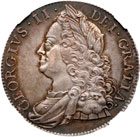 |
George II (1727-60), Silver Crown, 1750. Older laureate and draped bust left, GEORGIVS.II. DEI.GRATIA. toothed border around rim both sides, rev. crowned cruciform shields, garter star at centre, legend M.B.F.ET.H. REX. F.D.B. ET.L.D.S.R.I.A.T ET.E. edge inscribed in raised letters .DECVS. ET. TVTAMEN. ANNO REGNI. VICESIMO QVARTO, weight 30.08g (Bull 1670; ESC 127; S.3690). Attractively toned, with underlying mint bloom enhancing the design, just a hint of wear to the highest points probably from light cabinet friction, good extremely fine and scarce, slabbed and graded MS61. Estimated Value $7,500 - UP
NGC Certification 4628995-001. The Latin legends translate to on obverse "George II by the Grace of God" continuing on the reverse in abbreviated Latin which if in shown in full reads "Magnae Britanniae Franciae et Hiberniae Rex Fidei Defensor Brun et Lunebergen-sis Dux, Sacri Romani Imperii Archi-Thesaurius et Elector" and translates as "King of Great Britain, France and Ireland, Defender of the Faith, Duke of Brunswick and Luneberg, High Treasurer and Elector of the Holy Roman Empire."
View details and enlarged photos
Unsold |
|
Lot 3151 |
 |
George III (1760-1820), Gold Quarter Guinea, 1762. Long haired laureate head right, Latin legend and toothed border surrounding, GEORGIVS. III. DEI. GRATIA., rev. crowned quartered shield of arms, date either side of top crown, M.B.F. ET. H. REX. F.D. B. ET. L. DVX S.R.I.A.T. ET. E. edge diagonally grained (MCE 463; S.3741). Toned, has been graded and slabbed by NGC as MS63. Estimated Value $1,250 - UP
NGC Certification 3728329-006. At the time of writing we note that of 124 graded across both services that only 13 rate finer, meaning this piece hovers within the top 10% of the graded pieces. The abbreviated Latin legends translate as on the obverse "George the Third by the Grace of God," and on the reverse as "King of Great Britain, France and Ireland, Defender of the Faith, Duke of Brunswick and Luneberg, High Treasurer and Elector of the Holy Roman Empire."
View details and enlarged photos
Unsold |
|
Lot 3152 |
 |
George III (1760-1820), Silver Shilling, 1763. So-called Northumberland type, young laureate and draped bust right, Latin legend and toothed border surrounding, GEORGIVS. III DEI. GRATIA., rev. crowned cruciform shields, eight strings to Irish harp, garter star at centre, date either side of top crown, Latin legend and toothed border surrounding, M.B.F. ET. H. REX. F.D. B.ET. L. D. S. R. I. A. T ET. E., weight 6.00g (ESC 1214; Bull 2124; C&R 1004; S.3742). Attractively toned, just a few tiny flecks, otherwise a pleasing extremely fine, slabbed and graded by NGC as MS64. Estimated Value $3,000 - UP
NGC Certification 5880634-001. At the time of writing this coin currently ties for the highest graded 1763 Shilling at NGC who have graded 59 pieces. By comparison PCGS have graded 30 pieces and only one grades finer at a step higher. The Northumberland Shilling is so called because the Earl of Northumberland as the new Lord Lieutenant of Dublin in 1763 distributed £100 worth of these new coins, some two thousand pieces whilst parading on the streets of Dublin in Ireland. An old ticket accompanies this piece written in the hand of one of the earlier generations of the Baldwin family (early 20th Century) mentioning the £100 worth given out, and falsely giving the impression that £100 worth was the sum total issued, when in fact the calendar year of 1763 represented an output of 2,629 pounds in weight of silver for coinage. The coinage of 1763 consisted of maundy denominations and shillings only, and probably means that circa 100,000 shillings plus would have been issued which is still a very small figure as annual mintage goes.
Ex Spink Numismatic Circular, February 1995, item 228.
View details and enlarged photos
Realized
$3,075 |
|
Lot 3153 |
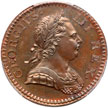 |
George III (1760-1820), Copper Proof Halfpenny, 1770. Laureate and cuirassed bust right, Latin legend and toothed border surrounding, GEORGIVS. III. REX. rev. struck en medaille, Britannia seated on globe left holding olive branch and spear, shield to rear, date in exergue, Latin legend and toothed border surrounding, BRITAN NIA. edge plain (Peck 895; S.3774). Attractively toned with hint of lustre and bluish colour, one tiny dig under breastplate, otherwise practically as struck, has been slabbed and graded by PCGS as PR65BN. Estimated Value $3,500 - UP
PCGS Certification 610325.65/80844304. At the time of writing we note that 16 pieces have been graded across both services of this the first year for the copper Halfpenny of George III, 50% of the population have graded finer.
The Latin legends translate as "George III King" on obverse, and on reverse "of the Britains."
View details and enlarged photos
Unsold |
|
Lot 3154 |
 |
George III (1760-1820), Gold Proof Guinea, 1774. Fourth laureate head right, GEORGIVS .III DEI.GRATIA., rev. crowned quartered shield of arms, date either side of crown, M.B.F. ET. H. REX. F.D. B.ET. L. D. S. R. I. A. T ET. E. (WR 95 R; MCE 379; S.3728). Attractively toned, just a few light hairlines, with die flaw to right of shield on reverse, has been graded and slabbed by NGC as PF63, very rare. Estimated Value $12,500 - UP
NGC Certification 4745877-001. We note across both services that at the time of writing only 23 examples of this rare proof have thus far been graded with the finest two being at 65 level. The Latin legends translate to on obverse "George III by the Grace of God" continuing on the reverse in abbreviated Latin which if in shown in full reads "Magnae Britanniae Franciae et Hiberniae Rex Fidei Defensor Brun et Lunebergen-sis Dux, Sacri Romani Imperii Archi-Thesaurius et Elector" and translates as "King of Great Britain, France and Ireland, Defender of the Faith, Duke of Brunswick and Luneberg, High Treasurer and Elector of the Holy Roman Empire." 1774 marks the first year for the fourth bust of George III and perhaps why a limited number of proof coins were struck. The Mint produced £4,685,624 worth of gold coin in the calendar year of 1774, a large amount as they were only striking gold and copper at this time with no silver output. The amount produced was also boosted by the fact that Parliament had passed an Act to call in all the underweight Guineas in circulation below 128 grains in weight. Conducted in two stages first all coin below standard weight was demonetized on 24th June 1774, with a second order specifically to demonetize guineas below 128 grains on 1st May 1776. The recoinage of the £16,500,000 called in accounted for high outputs until 1776, with much of the coin then finding its way across the Atlantic to the Americas.
View details and enlarged photos
Unsold |
|
Lot 3155 |
 |
George III (1760-1820), Silver Proof Shilling, 1787. Struck in fine silver, laureate and cuirassed bust right, legend surrounding with beaded outer border at raised rim both sides, GEORGIVS. III. DEI. GRATIA. rev. struck en medaille, cruciform shields, with semée of hearts in Hanoverian arms, crowns in angles, garter star at centre, date at bottom without stops either side, legend surrounding commences lower left, M.B.F. ET. H. REX. F.D. B.ET. L. D. S. R. I. A. T ET. E. plain edge, weight 6.43g (Bull 2132; ESC 1226; S.3746). Toned, a few light marks, good extremely fine, has been graded and slabbed by PCGS as PR62. Estimated Value $1,500 - UP
PCGS Certification 149832.62/34313088. The Latin legends translate to on obverse "George III by the Grace of God" continuing on the reverse in abbreviated Latin which if in shown in full reads "Magnae Britanniae Franciae et Hiberniae Rex Fidei Defensor Brun et Lunebergen-sis Dux, Sacri Romani Imperii Archi-Thesaurius et Elector" and translates as "King of Great Britain, France and Ireland, Defender of the Faith, Duke of Brunswick and Luneberg, High Treasurer and Elector of the Holy Roman Empire." This issue of the Proof Shilling was struck exclusively in pure silver for the use of the Bank of England along with pure silver Sixpences, and fine gold Guineas and Half-Guineas as of September 1787. The order was approved by the Master of the Mint on the 19th September and Lewis Pingo went ahead and struck 168 four coin groups of which this coin would have been one of 168 shillings struck. A contemporary record (Mint 1/14 p.12) shows that 100 of the four coin sets were for the Directors of the Bank of England, 18 for higher ranking officers, 38 for Royal Mint officials and 12 for the Company of Moneyers.
For further reading on the issue of 1787 Shillings and for a breakdown of some recipients of the sets of four coins see Appendix E in the article "The 1787 Shilling - A Transition in Minting Technique" by H E Manville and Prof. P P Gaspar, British Numismatic Journal, 2004, volume 74. Provenance: Purchased privately from Spink and Son Ltd. c.2005. This coin illustrated in "Coinage and Currency in Eighteenth Century Britain, The Provincial Coinage" by David W Dykes, page 38, number 32.
View details and enlarged photos
Realized
$1,599 |
|
Lot 3156 |
 |
George III (1760-1820). Gold "Spade" Guinea, 1787. Laureate head right. Rev. Arms on crowned, spade-shaped shield (S.3729). In PCGS holder graded as MS 61. Estimated Value $1,000 - UP
PCGS Certification 618045.61/36308667.
View details and enlarged photos
Realized
$2,276 |
|
Lot 3157 |
 |
George III (1760-1820), Silver Shilling, 1798. So-called Dorrien and Magens type, older laureate and cuirassed bust right, Latin legend and toothed border surrounding, GEORGIVS III DEI GRATIA. rev. cruciform emblematic shields, garter star at centre, crowns in angles, date at bottom with stop either side, Latin continuous legend and toothed border surrounding, M.B.F. ET. H. REX. F.D. B.ET. L. D. S. R. I. A. T ET. E. weight 6.04g (ESC 1227 R5; Bull 2139 R5; S.3742). Attractive even toning, good extremely fine and very rare, one of the key coins in the currency Shilling series, graded by NGC as MS62. Estimated Value $35,000 - UP
NGC Certification 5880636-001. At the time of writing we note only five examples of this extremely rare shilling have been graded by both services, each service recording one example grading finer, and this coin ties for second highest graded. The Latin legends translate to on obverse "George III by the Grace of God" continuing on the reverse in abbreviated Latin which if shown in full reads "Magnae Britanniae Franciae ET Hiberniae Rex Fidei Defensor Brun ET Lunebergen-sis Dux, Sacri Romani Imperii Archi-Thesaurius ET Elector" and translates as "King of Great Britain, France and Ireland, Defender of the Faith, Duke of Brunswick and Luneberg, High Treasurer and Elector of the Holy Roman Empire." The story of the Dorrien and Magens Shilling has been more fully written up in the past in volumes like John Craig's "The Mint" and a specific article by G P Dyer and P P Gasper in the British Numismatic Journal in 1982, volume 52 from which this footnote is sourced. Silver had been in short supply during the years of the Napoleonic Wars, and the Mint price that was paid to coin silver supplied was 62 Shillings for each pound of weight, with bankers and others having the right to bring silver in to sell at this level. As the price of silver generally remained higher than this coinage rate naturally no silver came in to the Mint, but around January to February of 1798 the price of silver fluctuated and dipped as low as 60 shillings a pound; so a group of bankers decided to exercise their right, and 9,895 pound weight of silver was physically presented to the Mint in tranches over the next few months, enough to produce over 600,000 shillings. The vociferous spokesperson of the group was Mr Magens Dorrien-Magens of 22 Finch Lane, who was a partner of the banking firm Dorrien-Magens, Mello, Martin and Harrison; who also sent some silver (perhaps in a private capacity) with the banker Mr Hoare. Other bankers that sent in silver were Barclay, Binn, Wood, Barnett, Robarts, Devaynes, Prescott and Hankey. Work started at the Mint to convert the bullion to silver Shillings dated 1798, as per the coin offered herewith; however the activity did not go un-noticed by the Committee on Coin, and a stop on more silver bullion coming in was made, with the issue of the coins effectively embargoed as of the 9th May 1798, when some 4,500 pound weight of the 9,895 pound total was still un-assayed. The exact reasons for stoppage are not specifically recorded, but Lord Liverpool the head of the committee and others were worried about the impact of a release of the shillings upon the flow of gold, which would no doubt be exchanged for the new silver to then be melted down as gold bullion, and leave the country at this difficult time of war. The bankers protested with Magens Dorrien-Magens as their spokesman in a petition of 28th June 1798 (Dorrien-Magens was in fact the earliest to deposit silver of the group of bankers), and payment was eventually granted as exchequer bills after the 20th July 1798 by which time the bankers were out of pocket from the loss of interest on the money tied up in the embargoed silver, with eventual payment of the same settled later by the 24th August 1798. As to the silver, the un-assayed portion was melted, along with perhaps as many as 34,000 of the coins and reformed as bars, but did not find its way to the Bank of England vault until an instruction of June 1799, with physical delivery in July. Dyer and Gaspar estimate that as much as 550 pounds weight of the silver may have been available as finished coin (c.34,000) by the 9th May 1798 but probably less (their estimate c.30,000). The quantity of this coin survived in the care of the Mint for up to 12 months before eventual melting to bars and sending to the Bank of England. There is a record MINT 9/212 dating from 1799 highlighting a discrepancy in the quantity of inferior silver that is equivalent to 4 pounds, 7 ounces and 8 penny weights of standard silver, compared to what it was on the 9th May 1798, indicating that perhaps up to 285 pieces had gone astray of the coins in the months the coins had laid idle. This would be a maximum number that escaped, and survival rates till present time are usually a very small percentage of what was available contemporarily at the time. When Dyer and Gaspar wrote their article in 1982 they traced only 14 examples which would indicate a survival of 5% of the maximum that could have escaped (still a high number compared to other currency coin survival rates). Today we can add some more to this number and there are perhaps just over twenty examples now known, eight being institutionalized in museums. This Shilling represents what is the ultimate currency Shilling date for the reign if not the series, with such an interesting story of economic and social history for an issue that was to be circulated in great quantity, but was embargoed and then the vast majority melted. This coin represents an extremely rare opportunity to own such an example as it seems only four examples including this have been available in the last ten years.
View details and enlarged photos
Unsold |
|
Lot 3158 |
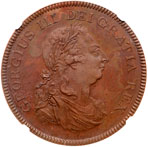 |
George III (1760-1820), Pattern Copper Crown, 1798. Struck by W J Taylor after C H Kuchler, laureate and draped bust right, : C. H. K on truncation, Latin legend and toothed border surrounding, GEORGIUS III DEI GRATIA REX., top leaf points to centre of letter E, rev. inverted die axis, crowned quartered shield of arms, date either side of top crown, abbreviated Latin legend and toothed border surrounding, M.B.F.ET.H.REX.F.D.B.ET.L.D.S.R.I.A.T.ET.E., edge plain (Dickinson 15 dies C/1a1; Bull 1908 R2; ESC 170; L&S 31). Has been graded and slabbed by NGC as PF64 BN. Estimated Value $2,750 - UP
NGC Certification 4864282-002. At the time of writing the only piece graded by NGC; for comparison we note PCGS have graded two examples of which one is finer. The Latin legends translate to on obverse "George III by the Grace of God" continuing on the reverse in abbreviated Latin which if in shown in full reads "Magnae Britanniae Franciae et Hiberniae Rex Fidei Defensor Brun et Lunebergen-sis Dux, Sacri Romani Imperii Archi-Thesaurius et Elector" and translates as "King of Great Britain, France and Ireland, Defender of the Faith, Duke of Brunswick and Luneberg, High Treasurer and Elector of the Holy Roman Empire." Reference: Pattern Crowns Dated 1798 by Michael Dickinson, Spink Numismatic Circular October 1999.
View details and enlarged photos
Realized
$3,444 |
|
Lot 3159 |
 |
George III (1760-1820), Gold Guinea, 1798. Fifth laureate head right, GEORGIVS .III. DEI.GRATIA, rev. spade shaped crowned quartered shield of arms, date below, legend reads in abbreviated Latin commencing lower left M.B.F. ET. H. REX. F.D. B.ET. L. D. S. R. I. A. T ET. E., weight 8.39g (MCE 402; S.3729). Toned, has been slabbed and graded by NGC as MS62. Estimated Value $2,000 - UP
NGC Certification 5880617-016. The Latin legends translate to on obverse "George III by the Grace of God" continuing on the reverse in abbreviated Latin which if shown in full reads "Magnae Britanniae Franciae et Hiberniae Rex Fidei Defensor Brun et Lunebergen-sis Dux, Sacri Romani Imperii Archi-Thesaurius et Elector" and translates as "King of Great Britain, France and Ireland, Defender of the Faith, Duke of Brunswick and Luneberg, High Treasurer and Elector of the Holy Roman Empire." The output of gold for 1798 calendar year was nearly three million pounds and it seems many were hoarded. This was because of events leading up to 1798 starting with the French Republic declaring war on Great Britain, Holland and Spain in 1793 with military expenditure initially draining gold coin from the country. By 1796 it had become necessary for the Bank of England to lend the Government a large amount of money and subsequently with fears of an invasion by the French in 1797 there was a run on the banks, and cash resources at the Bank of England ran alarmingly low. On 27th February 1797 the Privy Council issued an Order preventing the Bank of England making payments in cash and the Act of 1777 preventing banknote issue below £5 face value was rescinded. The problem of smaller coin for circulation was only partially solved by the issue of the new seven-shilling gold piece of one third of a guinea from 1797, as well as the countermarking of the large holding of Spanish Dollars in the Bank of England. It was in these times of uncertainty that the gold Guinea was no doubt the coin of choice to be hoarded.
View details and enlarged photos
Realized
$2,768 |
|
Lot 3160 |
 |
George III (1760-1820), Gold Third Guinea, 1803. Second type, first laureate head right, Latin legend and toothed border surrounding, GEORGIVS III DEI GRATIA., rev. large crown, date below crown, legend surrounding commencing at top, + BRITANNIARUM REX FIDEI DEFENSOR (MCE 455; S.3739). Lightly toned, good extremely fine, the last year for the type, has been graded and slabbed by NGC as MS63. Estimated Value $750 - UP
NGC Certification 4425376-007. We note that of 37 examples graded across both PCGS and NGC this coin falls into the top 5% of the roster of the highest grades, with only one piece graded higher at NGC. The Latin legends translate as on obverse "George III by the grace of God" and on the reverse "King of the Britains, Defender of the Faith." The gold coinage production for the year of 1803 amounted to £596,445 which would have consisted entirely of Half-Guineas and Thirds, the latter denomination being introduced to help alleviate the lack of silver coinage in circulation.
View details and enlarged photos
Realized
$861 |
|
Lot 3161 |
 |
George III (1760-1820), Gold Third Guinea, 1804. Third type, second laureate head right, Latin legend and toothed border surrounding, GEORGIVS III DEI GRATIA., rev. large crown, date below, legend surrounding commencing top, * BRITANNIARUM REX FIDEI DEFENSOR (MCE 456; S.3740). Toned, has been graded and slabbed by PCGS as MS62. Estimated Value $750 - UP
PCGS Certification 618017.62/33841615. We note at the time of writing that of the 57 examples of the 1804 Third Guinea currently graded at both services, only a total of four pieces are graded finer. The Latin legends translate as on obverse "George III by the grace of God" and on the reverse "King of the Britains, Defender of the Faith." The gold coinage production for the year of 1804 amounted to £718,397 which would have consisted entirely of Half-Guineas and Thirds, the latter denomination being introduced to help alleviate the lack of silver coinage in circulation.
View details and enlarged photos
Unsold |
|
Lot 3162 |
 |
George III (1760-1820), Gold Third Guinea, 1806. Third type, second laureate head right, Latin legend and toothed border surrounding, GEORGIVS III DEI GRATIA., rev. large crown, date below, legend surrounding commencing top, * BRITANNIARUM REX FIDEI DEFENSOR (MCE 457; S.3740). Toned, with some light flecking, a pleasing extremely fine, has been graded and slabbed by NGC as MS62. Estimated Value $750 - UP
NGC Certification 4346117-002. At the time of writing we note that of 45 examples graded across both PCGS and NGC this coin falls into the top 28% of the roster of the highest grades. The Latin legends translate as on obverse "George III by the grace of God" and on the reverse "King of the Britains, Defender of the Faith." The gold coinage production for the year of 1806 amounted to £405,106 which would have consisted entirely of Half-Guineas and Thirds, the latter denomination being introduced to help alleviate the lack of silver coinage in circulation.
View details and enlarged photos
Unsold |
|
Lot 3163 |
 |
George III (1760-1820), Gilt Copper Proof Farthing, 1806. Soho Mint Birmingham, early period, laureate and draped bust right, side whiskers rendered with incuse lines, incuse K on truncation for engraver Conrad Heinrich Kuchler, date below, Latin legend and beaded border surrounding, GEORGIUS III. D: G. REX. rev. inverted die axis, Britannia seated left on rock, holding olive branch and trident with shield, raised K to left on ground to left of shield, SOHO raised on rock to right, ship sailing right to left of Britannia, Latin legend and toothed border surrounding, BRITANNIA, edge grained (Peck 1387 KH13; S.3782). A few tiny marks, toned, practically as struck, has been graded and slabbed by NGC as PF64 Cameo. Estimated Value $500 - UP
NGC Certification 4928205-002. These special presentation proofs were struck in gilt copper at Matthew Boulton's Soho Mint Manufactory in Birmingham using the steam presses invented by James Watt. Boulton and Watt appear together on the reverse of the soon to be replaced UK £50 banknote. The Latin legend translates as "George III by the grace of God, King" and on the reverse "of Britain."
View details and enlarged photos
Realized
$707 |
|
Lot 3164 |
 |
George III (1760-1820), Gold Third Guinea, 1810. Third type, second laureate head right, Latin legend and toothed border surrounding, GEORGIVS III DEI GRATIA. rev. large crown, date below, legend surrounding commencing top, * BRITANNIARUM REX FIDEI DEFENSOR (MCE 460; S.3740). Toned a little unevenly, good extremely fine, has been graded and slabbed by PCGS as MS62. Estimated Value $750 - UP
PCGS Certification 618040.62/34958639. At the time of writing the PCGS population report shows a total of 41 examples graded of this date, with only five graded higher. For comparison NGC have graded 72 examples of which only 14 are higher. The Latin legends translate as on obverse "George III by the grace of God" and on the reverse "King of the Britains, Defender of the Faith."�The gold coinage production for the year of 1810 amounted to £316,936 which would have consisted entirely of Half-Guineas and Thirds, the latter denomination being introduced to help alleviate the lack of silver coinage in circulation.
Ex Stacks Bowers, Hong Kong Auction, 2nd April 2018, lot 53759.
View details and enlarged photos
Unsold |
|
|
|